Letters A, B, C and D are written on a cardboard as shown in the figure below. The cardboard is kept at a suitable distance behind a transparent empty glass of cylindrical shape. If the glass is now filled with water, one sees an inverted image of the pattern on the cardboard when looking through the glass. Ignoring magnification effects, the image would appear as
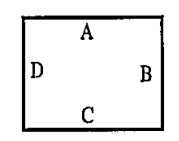
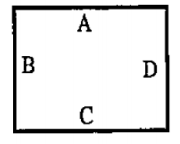

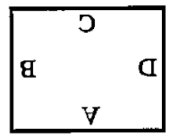

Step by step video & image solution for Letters A, B, C and D are written on a cardboard as shown in the figure below. The cardboard is kept at a suitable distance behind a transparent empty glass of cylindrical shape. If the glass is now filled with water, one sees an inverted image of the pattern on the cardboard when looking through the glass. Ignoring magnification effects, the image would appear as by Physics experts to help you in doubts & scoring excellent marks in Class 11 exams.
Similar Questions
In a YDSE experiment the two slits are covered with a transparent membrane of negligible thickness which allows light to pass through it but does not allow water. A glass slab of thickness t=0.41mm and refractive index μg=1.5 is placed infront of one of the slits as shown in the figure. The separation between the slits is d=0.30mm. The entire space to the left of the slits is filled with water of refractive index μw=4/3.
A coherent light of intensity I and absolute wavelength λ=5000Å is being incident on the slits making an angle 30∘ with horizontal. If screen is placed at a distance D=1m from the slits, find
(a) the position of central maxima.
(b) the intensity at point O.
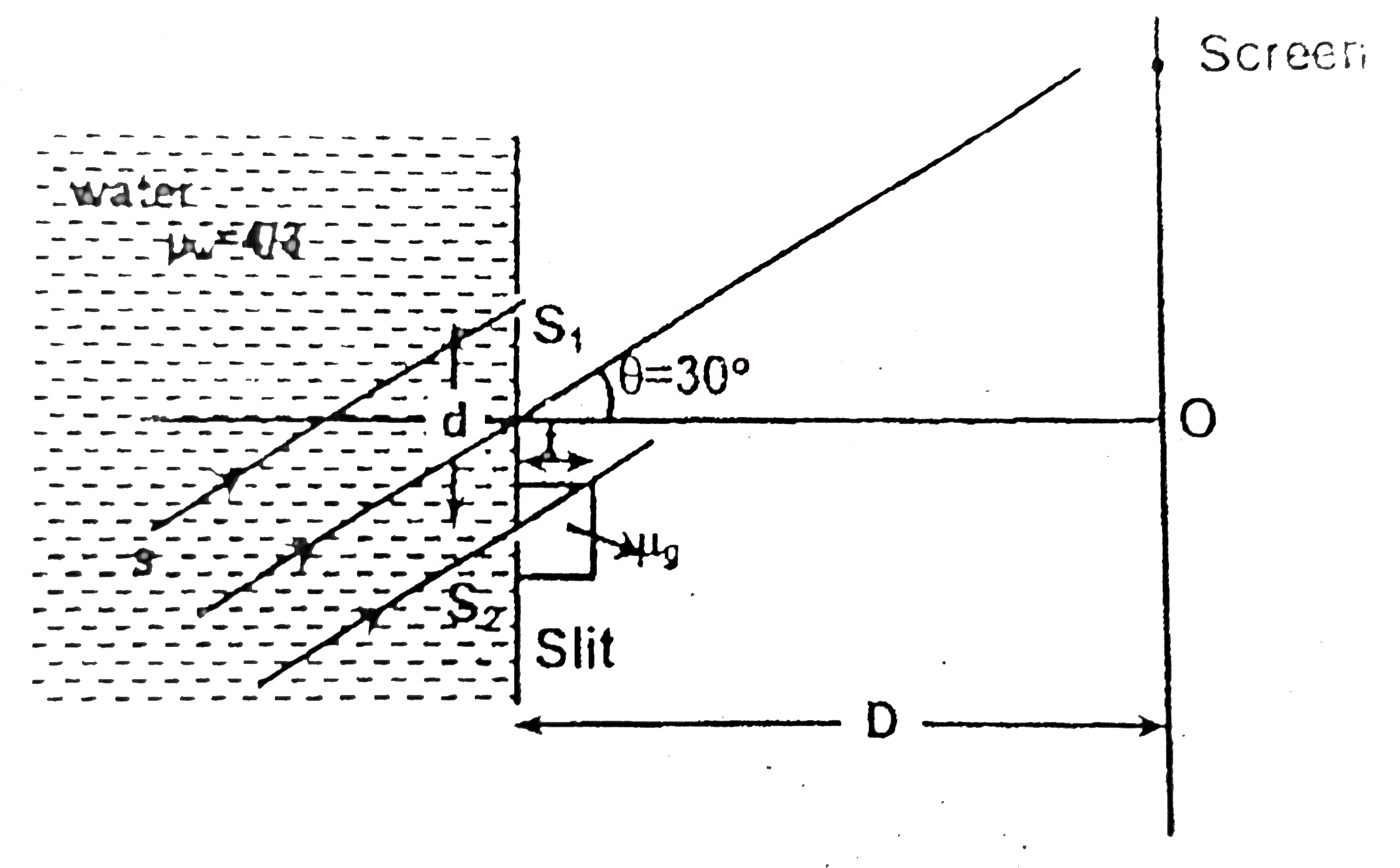 View Solution
View SolutionThe convex surface of a thin concave-convex lens of glass of refractive index 1.5 has a radius of curvature 20 cm. The concave surface has a radius of curvature 60 cm. The convex side is silvered and placed on a horizontal surface as shown in figure. (a) Where should a pin be placed on the axis so that its image is formed at the same place ? (b) If the concave part is filled with water (mu = 4/3), find the distance through which the pin should be moved so that the image of the pin again coincides with the pin.
 View Solution
View Solution
Knowledge Check
- Question 1 - Select One
Lenses made of transparent materials such as glass or plastic with curved surfaces. Diverging lenses are thicker at their edges than at their centres and make light rays passing through them spread out. Converging lenses are thicker in middle than at edges and make light rays passing through them focus at a point.
Abhishek uses two lenses I and II of same size and same material as shown P1 and P2 are the powers of A and B. An object is kept at the same distance from the lenses between Fand 2F of each lens on the principal axis in turn Let li and la be the image formed by two lenses respectively. Which one of the following statements is correct for the images formed?
 ADistance or image l2 will be less than distance or image l1 from the lensBSize or image l1 will be equal to size or image l2CDistance of image l2 will be be greter than distnace or image l1 iron the lensDSize of image l1 will be tesser than size or image l2
ADistance or image l2 will be less than distance or image l1 from the lensBSize or image l1 will be equal to size or image l2CDistance of image l2 will be be greter than distnace or image l1 iron the lensDSize of image l1 will be tesser than size or image l2 - Question 2 - Select One
Read the following text and answer the following questions on the basis of the same
Photocell: A photocell is a technological application of the photoelectric effect. It is a device whose electrical properties are affected by light. It is also sometimes called an electric eye. A photocell consits of a semi-cylindrical photo-sensitive metal plate C(emitter) and a wire loop A (collector) supported in an evacuated glass or quartz bulb. It is connected to the external circuit having a high tension battery B and micro ammeter (μA) as shown in the Figure.
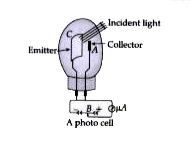
Sometimes, instead of the plate C, a thin layer of photoensitive material is pasted on the inside of the bulb. A part of the bulb is left clean for the light to enter it. when light of suitable wavelength falls on the emitter C, photoelectrons are emitted. These photoelectrons are drawn to the collect A. Photocurrent of the order of a few microampere can be normally obtained from a photo cell. A photocell converts a change in intensity of illumination into a change in photocurrent. This current can be used to operate control system and in light measuring devices.
Photocell is an application ofAthermoelectric effectBphotoelectric effectCphotoresistive effectDNone of the above - Question 3 - Select One
Read the following text and answer the following questions on the basis of the same
Photocell: A photocell is a technological application of the photoelectric effect. It is a device whose electrical properties are affected by light. It is also sometimes called an electric eye. A photocell consits of a semi-cylindrical photo-sensitive metal plate C(emitter) and a wire loop A (collector) supported in an evacuated glass or quartz bulb. It is connected to the external circuit having a high tension battery B and micro ammeter (μA) as shown in the Figure.
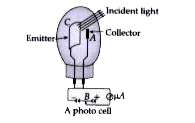
Sometimes, instead of the plate C, a thin layer of photoensitive material is pasted on the inside of the bulb. A part of the bulb is left clean for the light to enter it. when light of suitable wavelength falls on the emitter C, photoelectrons are emitted. These photoelectrons are drawn to the collect A. Photocurrent of the order of a few microampere can be normally obtained from a photo cell. A photocell converts a change in intensity of illumination into a change in photocurrent. This current can be used to operate control system and in light measuring devices.
Which of the following statement is true?AThe photocell is total painted blackBA part of the photocell is left clean.CThe photocell is completely transparentDA part of the photocell is made black.
A small object (A) is placed on the principal axis of an equiconvex lens at a distance of 30 cm. The refractive index of the glass of the lens is 1.5 and its surfaces have radius of curvature R=20cm. Two glass slabs S1 and S2 have been placed behind the lens as shown in Figure. Thickness of the two slabs is 6 cm and 4 cm respectively and their refractive indices are 32 and 2 respectively.
(a) Find the distance of the final image measured from the lens. Also find the magnification.
(b) How does the position of the image change if the slab S2 is moved to left so as to put it in contact with S1.
(c) How does the position of the image change if the two slabs in contact are together moved to right by a distance of 100 cm.
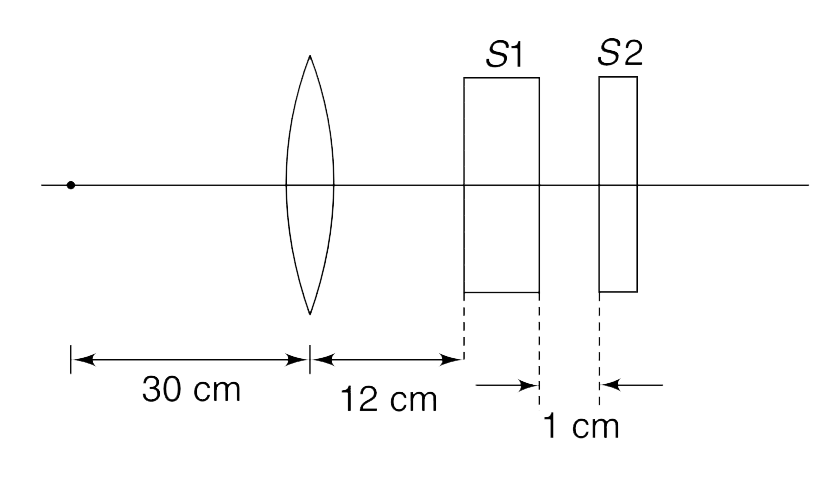 View Solution
View SolutionOne end of a cylindrical glass rod shown in figure, is ground to a hemispherical surface of radius R=20mm.
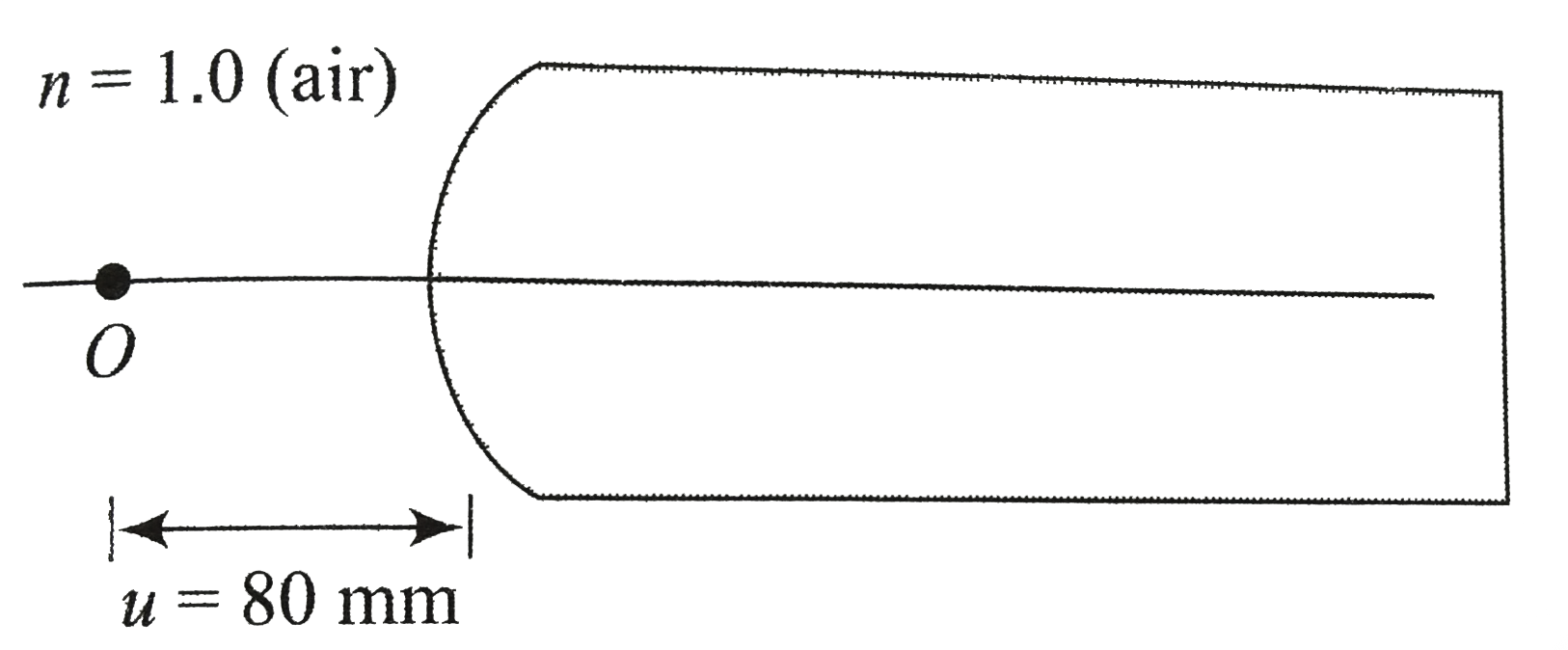
a. Find the image distance of a point object on the axis of the rod, 80mm to the left of the vertex. The rod is in air.
b. Let the same rod be immersed in water of refractive index 4/3 , the other quantities having the same values as before. Find the image distance.View SolutionA large squre container with thin transparent vertical walls and filled with water ( refractive index 43) is kept on a horizontal table . A student holds a thin straight wire vertically inside the water 12cm from one of its corners, as shown schematically in the figure . Looking at the inside the water 12 cm from one of its corners, as shown schematically in the figure . Looking at the wire from this corner, another student sees two images of the wire , located symmetrically on each side of the line of sight as shown. THe separation (in cm) between these images is _______ .
View SolutionIn the figure shown a parallel plate capacitor is connected across a source of emf ε. The plates are square shaped with edge 'l' and separated by a distance d. A dielectric slab of dielectric constant k and thickness d is inserted between the plates with constant speed v. Find the current in the connecting wires, ignore the resistance of connecting wires. A current of equal strength is passed through a coil of resistance R and dipped into water kept in a bucket at 0∘C. What would be the temperature of the water at the end of 5 minutes if mass of the water is m and specific heat of the water is c?
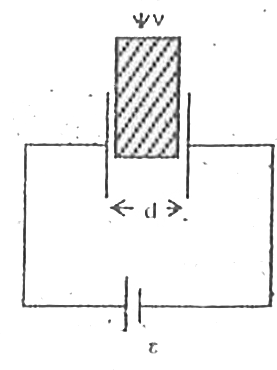 View Solution
View SolutionRead the following text and answer the following questions on the basis of the same
Photocell: A photocell is a technological application of the photoelectric effect. It is a device whose electrical properties are affected by light. It is also sometimes called an electric eye. A photocell consits of a semi-cylindrical photo-sensitive metal plate C(emitter) and a wire loop A (collector) supported in an evacuated glass or quartz bulb. It is connected to the external circuit having a high tension battery B and micro ammeter (μA) as shown in the Figure.

Sometimes, instead of the plate C, a thin layer of photoensitive material is pasted on the inside of the bulb. A part of the bulb is left clean for the light to enter it. when light of suitable wavelength falls on the emitter C, photoelectrons are emitted. These photoelectrons are drawn to the collect A. Photocurrent of the order of a few microampere can be normally obtained from a photo cell. A photocell converts a change in intensity of illumination into a change in photocurrent. This current can be used to operate control system and in light measuring devices.
Photosensitive material shoudl be connected toView Solution

